True crime and mystery buffs have probably heard stories of the ways in which household ingredients and common medicine cabinet finds, like decongestant eye drops, have been used to incapacitate or even murder unwitting victims. But you don’t have to plot first-degree murder in order to be harmed by seemingly innocuous ingredients. It’s much less likely, of course, that you’ll sustain serious harm from these OTC drugs and supplements without malicious intent, but it can still happen. Here are some of the potential dangers lurking in your cabinets that you should be aware of.
Risks of Tylenol (acetaminophen)
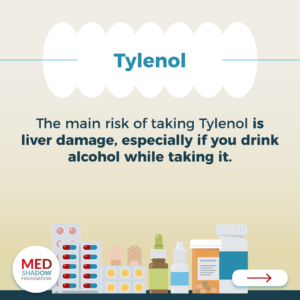
The main risk of taking Tylenol is liver damage, especially if you drink alcohol while taking it. While it isn’t common, one study in JAMA found that taking acetaminophen at the recommended dose for four days in a row could elevate your risk of liver damage.
Signs of liver damage include:
- Nausea, vomiting, or loss of appetite
- Fatigue or weakness
- Jaundice (yellowing of the skin or eyes)
- Pain in the upper right part of the abdomen
Read more about the risks and benefits of Tylenol in MedShadow’s Need to Know: Acetaminophen.
Risks of Aspirin, Advil (ibuprofen), or Aleve (naproxen)
All OTC NSAIDs can cause serious side effects, including stomach ulcers, gastrointestinal (GI) bleeding, kidney failure, heart attacks, and strokes. Aspirin is the exception. It can cause GI bleeding and stomach ulcers, but not heart attacks and strokes.
The risk of these side effects of NSAIDs increases at higher doses, and if you take the drug for longer periods of time. That means if your pain lasts more than two or three days, you might consider contacting your healthcare provider rather than continuing to take an NSAID at home.
More common side effects of taking NSAIDs are stomach issues like irritation, belly pain, heartburn, gas, bloating, constipation, and diarrhea. Taking your NSAIDs with food or milk can help these sensations. Dizziness, mild headaches, problems concentrating, balance issues and lightheadedness are also common.
Read more about the side effects of NSAIDs in MedShadow’s The Lowdown on NSAIDs for Pain and Need to Know: NSAIDs.
Risks of Cold Medicine
Depending on your cold symptoms, there are several different OTC medications you might consider taking. For example, you might try acetaminophen for pain or to lower your temperature, and a decongestant if you’re stuffed up. What many of us end up doing is reaching for a drug with a combination of active ingredients, such as Nyqil, which contains acetaminophen to treat aches and fever, dextromethorphan for coughs, phenylephrine for congestion and doxylamine to help you sleep.
The more active ingredients in the drug, the higher the risk of side effects. Another risk comes from mixing OTC medicines. You might take Tylenol then, an hour or so later, take Nyquil, not realizing that you’re doubling up on the pain reliever, acetaminophen.
Risks of OTC Antihistamines
Most common allergy OTC medications contain antihistamines. Histamines, the compounds these drugs block, are made by your body when it recognizes an allergan, like pollen, as a threat. They are responsible for many different types of symptoms such as the swelling and redness of a bug bite or the excess mucus in your nose on a spring day.
There are two generations of antihistamines. The first generation are older antihistamines, such as Benadryl, that cross the blood-brain barrier more efficiently than the newer ones, such as Claritin and Zyrtec, and thus are more likely to cause certain side effects like drowsiness and constipation.
Side effects of antihistamines may include:
- Drowsiness
- Constipation
- Dry mouth, eyes, and skin
- Nausea, abdominal pain
- Low blood pressure
- Increased heart rate
If you’re using Zyrtec-D or Claritin-D, which are designed to treat congestion along with allergies, you may also experience an increased heart rate.
Researchers have found that taking anticholinergic drugs (a type of drug that includes antihistamines as well as drugs for Parkinson’s, incontinence and more) is associated with a higher risk of developing dementia. More recently work has shown that the risk emerges in patients who had been taking a regular daily dose of anticholinergic drugs for three years. The longer they used them or the higher the dose, the higher the risk.
If you take antihistamines regularly, it’s especially important to make sure you’re not unintentionally ingesting things that can interact with them.
Avoid mixing antihistamines with:
- Alcohol
- Stomach ulcer medications
- Antidepressants
- Cold medicines also containing antihistamine
Eye Drops
Some types of eye drops also contain antihistamines. Others contain decongestants.
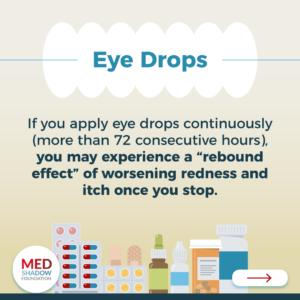
Common OTC side effects of allergy eye drops include:
- Burning eyes
- Stinging eyes
- Headache
- Stuffy or runny nose
- Bad taste in your mouth
- Increased sensitivity to light.
Be wary about using eye drops with other decongestants. Drugs like Visine Original Red Eye Drops or Clear Eyes Redness Relief constrict the blood vessels to reduce redness. For that reason, you shouldn’t use them for more than 72 hours consecutively. Doctors warn that if you apply the drops continuously, you may experience a “rebound effect” of worsening redness and itch when you stop the treatment.
Risks of Proton Pump Inhibitors (PPIs) for Reflux
Many of us keep PPIs such as Prilosec, which you can take early in the day to prevent acid reflux later in the day, on hand to prevent acid reflux or heartburn. OTC versions of PPIs are meant to be taken daily for 14 days, then discontinued, to help you battle reflux. However, some people take them more regularly or receive prescriptions from their healthcare providers to take them for months or years at a time. Over time, PPIs can make it hard for your digestive system to absorb certain nutrients, leading to deficiencies in vitamins such as B12, which can lead to anemia and nerve damage.
Some side effects of these OTC medications include:
- Osteoporosis
- Stomach and other infections
- Kidney problems
- Heart disease
- Stomach cancer
Even though some PPIs are available over the counter, they can still interact with prescription medications you may be taking such as benzodiazepines, methotrexate for cancers and autoimmune disorders, and even iron supplements. Make sure your doctor knows if you use PPIs and how often.
It is also important to note that it can be difficult to stop taking PPIs. Abruptly discontinuing can cause a rebound effect that worsens your reflux symptoms. “I was prescribed high levels of omeprazole, after complaints of GERD to my doctor,” says Melissa Finley, editorial content manager of MedShadow. “I was on them for years, and coming off was incredibly difficult. It took a tapering schedule I created myself to eventually come off of them altogether.”
“Doctors often give you a prescription and have you start a medication, but seldom tell you it is time to stop, or even how to stop!” says Finley. “Eventually, tapering slowly combined with a better diet helped me to get off of PPIs for good. I stick to Tums for the rare occasion of reflux now.”
Risks of Leftover Antibiotics
Antibiotics are only available with a prescription, yet many of us may still have them in our medicine cabinets. While your physician will usually prescribe only the exact dose you need, sometimes you’ll switch from one drug to another, you’ll be prescribed extra pills, or you may even decide to stop taking them early because you feel better. (You should finish the course even if you start to feel better, unless your healthcare provider tells you otherwise.) Nearly half of parents whose children were prescribed antibiotics saved some, according to Consumer Reports. And almost 75% of those parents went on to use them or share them with others who wanted the treatment. 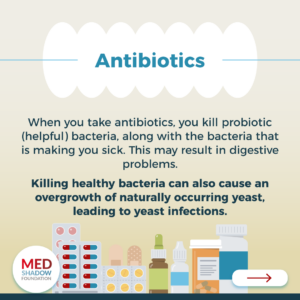
You should never use antibiotics without a prescription. Doing so contributes to growing antibiotic resistance. When bacteria are exposed to antibiotics but not all of them are killed, they are more able to resist that drug in the future. More than 35,000 people in the U.S. die of antibiotic-resistant infections each year. It is important to note,antibiotics don’t treat infections caused by viruses, which is why it’s important your doctor determines that your symptoms are caused by bacteria before you take the drugs.
Plus, antibiotics come with a variety of side effects. One of the most common is diarrhea or nausea. Along with any bacteria that are causing your symptoms, your body is home to trillions of helpful bacteria, many of which live in your digestive tract. When you take antibiotics, you kill many of these microbes along with the ones making you sick, causing digestive problems. Killing these bacteria can also give room for yeast to take over, leading to yeast infections.
Approximately 70,000 kids in the U.S. end up in the emergency room every year due to severe allergic reactions or other adverse reactions to antibiotics, according to a CDC analysis.
Additional side effects of antibiotics include:
- Rash
- Sore throat
- Respiratory difficulties
- Nausea and vomiting
- Diarrhea
- Stomach pain
- Swelling of joints
- Stevens-Johnson Syndrome (a rare skin disorder most associated with sulfonamides such as Bactrim)
- Retinal detachment
- Compromised kidney function, associated with fluoroquinolones such as Cipro, Levaquin (levofloxacin) and Avelox (moxifloxacin)
- Widespread pain (with symptoms similar to fibromyalgia)
- Tendinitis
- Heart palpitations
- Muscle spasms
To learn more, read MedShadow’s The Pros and Cons of Antibiotics.
Risks of Leftover Opioids
By now, most of us probably know that when you are prescribed opioids, you are at a risk of developing an opioid use disorder. As with any drug, it’s best to take the lowest effective dose for the least amount of time to reduce your risk. Doing so may mean you have some drugs leftover.
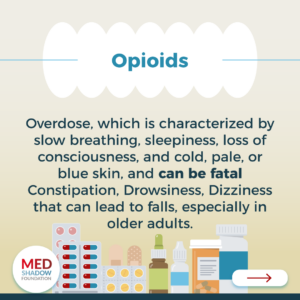
Keeping these extra pills in your medicine cabinet not only increases your own risk of developing an opioid use disorder, but it also increases the risk for anyone in your household who may find them, including kids and teenagers.
Opioids also come with additional side effects, especially if they’re taken with other drugs such as sedatives. Side effects of opioids include:
- Overdose, which is characterized by slow breathing, sleepiness, loss of consciousness, and cold, pale, or blue skin, and can be fatal
- Constipation
- Drowsiness
- Dizziness that can lead to falls, especially in older adults
How to Dispose of Leftover Medicines
To reduce the risk your unused medicines pose to you or or anyone else in your home, be sure to dispose of extra pills when you’re done with your prescription. Don’t hold on to them “just in case.” In some areas, you can bring your unused medications to pharmacies or police stations. For more information, read MedShadow’s What To Do with Leftover Prescription Pain Pills.
Popular Vitamins and Supplements
Because supplements are not regulated by the Food and Drug Administration (FDA) the same way as drugs, there’s often the potential that they could be contaminated. If you decide to take any vitamins or supplements, be sure to check the labels to see that they have been examined by a third party for purity. Also, discuss them with your healthcare provider, because they can interfere with other treatments. Even if the vitamins are free of contamination, taking supplements in high doses that you don’t need can cause problems.
Risks of Vitamin D
In 2022, vitamin D was the most commonly purchased dietary supplement, according to Consumer Reports. This hormone-like vitamin is important in many aspects of health, from supporting your mood and immune system to strengthening bones. However, the vitamin is fat soluble, meaning it’s easier to end up taking too much (water soluble vitamins are cleared from your body faster through your urine than fat-soluble ones).
Dangers of taking too much vitamin D include:
- Nausea
- Weakness,
- kidney stones
- Irregular heartbeat
- Death
While a third of adults in the U.S. fall into the category of “vitamin D deficient,” there is also debate among experts about how much vitamin D you really need.
Risks of Fish Oil
Fish oil was the third-most commonly purchased supplement in 2022, according to Consumer Reports. The omega-3 fatty acids found in fish oil supplements are thought to improve your cardiovascular health by lowering triglycerides and may be helpful for people with certain conditions such as rheumatoid arthritis.
Aside from potential contamination, there are few risks associated with omega-3 supplements. They can cause gastrointestinal symptoms like diarrhea or indigestion in some people, and they may be unsafe for people with seafood allergies.
Because of the anti-clotting properties of these supplements, people taking blood-thinning medications or NSAIDs, such as over-the-counter pain relievers, should consult a healthcare provider before supplementing with omega-3 products.
OTC Risks of Coenzyme Q 10 (CoQ-10)
The fourth-most commonly purchased supplement in 2022, according to Consumer Reports, is COQ-10. It’s thought to support cardiovascular health and help prevent migraines, depression, and dementia.
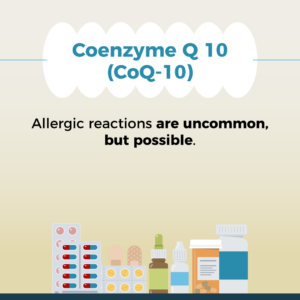
While CoQ10 supplements are generally well-tolerated, they can cause nausea, diarrhea, and insomnia, particularly at high dosages. Some people are also allergic to ubiquinol and should seek immediate medical attention if they experience difficulty breathing, tightness in the chest, hives, rash, or swelling of the mouth, face, lips, or tongue.
The OTC supplements can interact with blood thinners and cancer medications, so be sure to speak to your healthcare provider before taking it.
Just because some drugs and supplements are available OTC, or are prescribed frequently, doesn’t mean they’re harmless. Usually, taking them for the shortest period of time necessary and at the lowest possible dose will be enough to lower the risk of side effects, but many times the greatest harm comes from using multiple treatments at once, or taking them for long periods of time. Make sure you speak with your healthcare provider about what you’re taking and how long you’ve been taking it at every visit.






